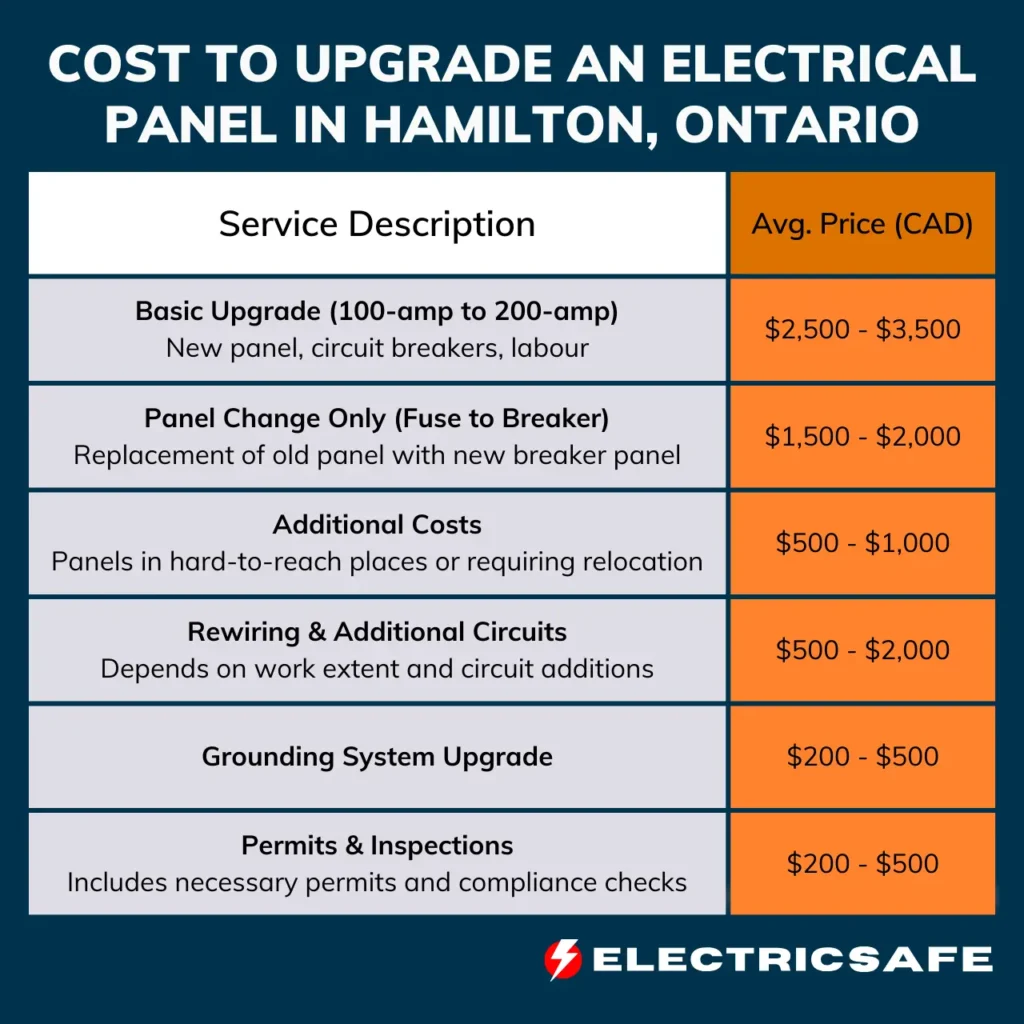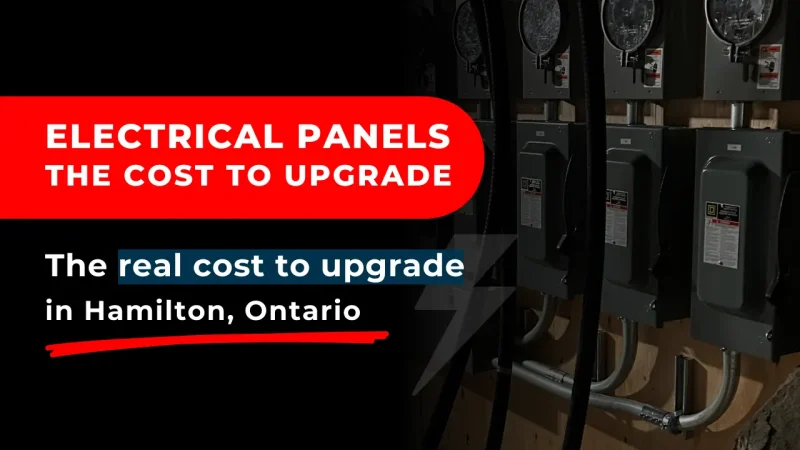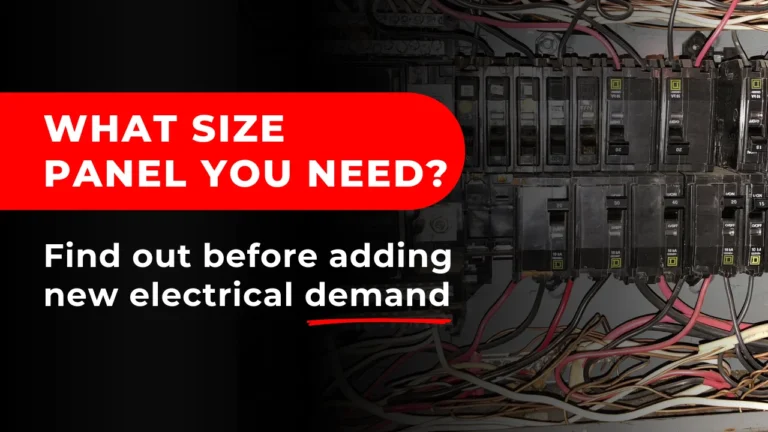You’ve taken the plunge and bought a charming old house in Dundas. So far, you absolutely love it. The streets are tree-lined, a great school is around the corner, and the neighbours are amazing- what more could you ask for?
However, as you start unpacking and setting up your new space, you soon notice a few things that make you nervous. To begin with, some outlets also don’t seem to work like they’re supposed to; when you plug in your coffee maker or TV, you see the odd spark. This leaves you feeling uneasy about how safe you might be in your new home.
Concerned about these problems, you decide to call a licensed electrician for a home electrical inspection to see what’s wrong. It turns out that your electrical panel is outdated and unable to handle the demands of modern appliances and devices. In short, you need an electrical panel upgrade. The question is- how much does it cost?
In this blog, we’ll highlight everything you need to know about electrical panel upgrades and the associated costs.
What Influences the Cost of Electrical Panel Upgrades?

How much do electrical panel upgrades cost in Hamilton, Ontario? Well, prices range from city to city, but the cost to upgrade an electrical panel in Hamilton typically ranges between CAD $2,500 to CAD $3,500.
For a panel change only (fuse to breaker) you’re looking at about CAD $1,500 to CAD $2,000.
But that’s just a ballpark quote. Here’s a closer look at what these costs include.
Basic Upgrade (100-amp to 200-amp)
Upgrading from a 100-amp panel to a 200-amp panel can cost between $2,500 and $3,500. This price range includes the cost of the new panel, circuit breakers, and labour. The new panel allows your home to handle more electrical load, which is essential for modern appliances and devices. If you’re looking for a panel change only (fuse to breaker), the cost ranges from $1,500 to $2000.
Location and Accessibility
If your panel is in a hard-to-reach place, like a crawl space or behind finished walls, expect to pay an additional $500 to $1,000. Electricians need more time and effort to access and replace panels in these locations. Sometimes relocating the panel to a more accessible spot is necessary, which adds to the overall cost.
Additional Electrical Work
Rewiring is often necessary if the existing wiring is outdated or unsafe. It can cost between $500 and $2,000, depending on the extent of the work required. Adding new circuits to support additional outlets or appliances also increases the expense, as each new circuit can cost between $100 and $250.
Modern electrical codes require proper grounding for safety, so upgrading an old grounding system to meet current standards can add another $200 to $500. These additional upgrades ensure your home’s electrical system is up-to-date and safe but will require a higher investment.
Permits and Inspections
In Ontario, electrical work must comply with strict regulations, requiring permits and inspections. Obtaining the necessary permits typically costs between $200 and $500, depending on your municipality and the scope of work.
After completing the upgrade, an inspection is conducted to verify compliance with the electrical code. While this fee is often included in the permit cost, it can sometimes be an additional expense.
Why Upgrade Your Electrical Panel?

Older homes often have outdated electrical systems that can’t handle modern power needs, which can lead to dangerous problems like the ones you encountered. When you upgrade your panel, you realize several benefits, some of which are highlighted below.
Handle Greater Electrical Loads
Modern panels are designed to manage higher electrical loads, which reduces the risk of overheating and fire hazards. An upgrade is typically required when you need to rewire your kitchen, finish your basement, or use more power for appliances like a hot tub or car charger. This step ensures that your system complies with current electrical codes and standards, which have become more stringent over the years to protect homeowners.
Improve Electrical System Performance
After upgrading your electrical panel, you will soon notice that your appliances run more efficiently. This is because a modern electrical panel provides a more stable and consistent power supply. You can also add more circuits to your home, allowing for the installation of new outlets and the connection of more appliances without overloading the system.
Stop Circuit Breakers From Tripping
Tripping breakers are a common issue in older homes with outdated panels. This happens when the panel cannot handle the electrical load, causing it to shut off to prevent overheating. While this safety feature is important, it can be very inconvenient. Upgrading your panel to a higher capacity, such as from 100-amp to 200-amp, can resolve this issue.
Increase Your Home’s Resale Value
An upgraded electrical panel can increase the value of your home. Prospective buyers are often concerned about the condition of a home’s electrical system. A modern, upgraded panel is a strong selling point as it indicates that the home is well-maintained and capable of supporting modern electrical needs. This can make your home more attractive on the market and potentially lead to a higher resale value.
What’s the Installation Process for an Electrical Panel?
Understanding the installation process can help you prepare for what to expect cost-wise.
Assessment
First, a licensed electrician will inspect your current electrical system. They will check the condition of your existing panel, wiring, and overall setup. During this assessment, the electrician will also discuss your power needs. They will consider the number of appliances, electronic devices, and future plans for your home. Based on this assessment, they will recommend a suitable panel size. They may also suggest any additional work required, such as rewiring or adding new circuits.
Permits
Before starting the work, the electrician will obtain the necessary permits. Electrical work in Ontario must comply with safety regulations, which include obtaining proper permits. These permits ensure that the work is done according to current electrical codes. The cost of permits typically ranges from $200 to $500, depending on your municipality and the scope of the work.
Installation
Once the permits are in place, installation begins. The electrician will disconnect the power to your home before removing the old electrical panel. The new panel is then installed in place of the old one. The electrician will reconnect all the circuits and wires to the new panel and run some tests to make sure it operates as it should.
Inspection
After the installation is complete, an inspection is required to confirm that the work meets Ontario’s electrical code. The inspector will look at the new panel, the connections, and any additional work done, such as rewiring or adding circuits. If everything meets the code, they will approve the work. If there are any issues, the electrician will need to address them before the inspector gives the final approval.
Final Steps
After passing the inspection, the electrician will restore power to your home. They will perform a final check to ensure everything is working correctly before giving you documentation confirming that the work complies with Ontario’s electrical standards. If you eventually decide to sell your home, this paperwork shows potential buyers that your electrical system is safe and up-to-date.
Common Misconceptions About Panel Costs

There are a few misconceptions about electrical panel upgrades that are worth addressing.
“It’s Too Expensive”
While the initial cost might seem high, the long-term benefits justify the investment. An updated panel reduces the risk of electrical fires and ensures your home can handle modern electrical demands. This upgrade can also prevent costly repairs and replacements in the future. By investing in an upgrade now, you save money later.
“It Takes Too Long”
Most upgrades are completed in a single day. A qualified electrician assesses your needs, secures the necessary permits, and then performs the installation with minimal disruption to your daily routine.
“Only Old Homes Need Upgrades”
Even modern homes can find their existing panels insufficient. Upgrading ensures your panel can handle the load, regardless of your home’s age. It’s not just about the age of the home but the capacity and condition of the electrical system. An upgrade can provide the power needed for today’s technology and future-proof your home.
A Successful Panel Upgrade Starts With a Top-Rated Electrician
If you’re experiencing issues like frequently tripped breakers, it might be time to consider an upgrade. At ElectricSafe, located in Hamilton, ON, we offer professional electrical panel upgrade services. We provide detailed estimates, quality workmanship, and a warranty on our services, so contact ElectricSafe today to schedule an assessment and take the first step toward a safer, more reliable electrical system for your home.




